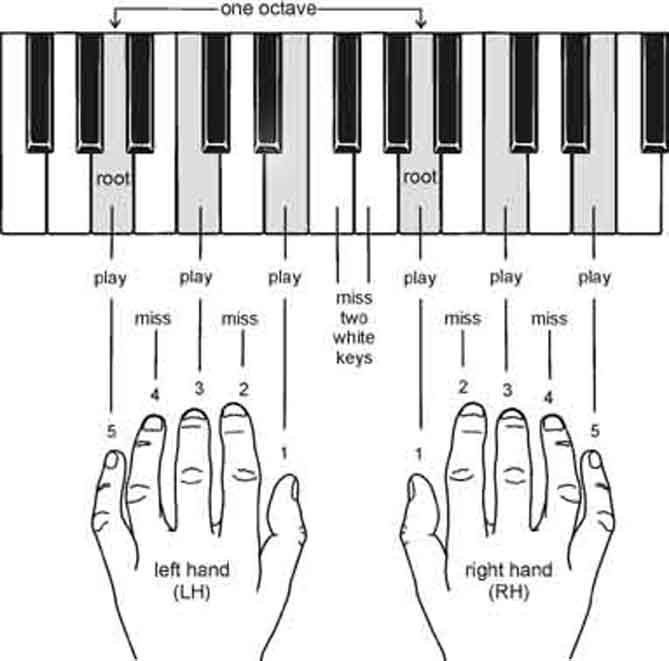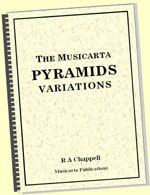The Musicarta
Pyramids Variations
~ Sample Content Pages ~
If you want to ‘just sit down and play the piano’, what should you do with your hands?
Musicarta’s Basic Music-making Position has the answer! The Basic Music-making Position IS piano-chords-made-easy!
If you put your hands on the keyboard in this general position:

... you CAN'T GO WRONG!
The Musicarta Basic Music-making Position
Each hand covers five white keys, with two unused white keys between the hands. You play the notes under fingers 1, 3 and 5 of each hand, and miss out the notes under fingers 2 and 4 (play one, miss one, play one, miss one, play one).
The two unused keys between the two hands ensure that the right hand notes sound good with the left hand notes – the bottom note in each hand is the same. In musical jargon, both hands are playing 'triads in root position'.
Using the BMP to play chord sequences
The Basic Music-making Position makes it easy to play chords from a chord sequence because these chords are named after their lowest (left-most) note.
The hands in the illustration are arranged to play an A minor chord. The lowest note of each chord – left hand little finger (LH5) and right hand thumb (RH1) – is an A. If you copy the illustration accurately and play around with the notes under your fingers, you will sound something like this:
You are playing an A minor chord – indicated as ‘Am’ in chord charts and popular sheet music. The Pyramids Variations pdf shows you what this chord looks like in written music, too.
|
The PYRAMIDS VARIATIONS The Musicarta Pyramids Variations aims to exceed expectations by coaching beginners and re-starters to an impressive ‘Concert Performance’ in just eight lessons. After that, you learn a set of variations which model all the contemporary keyboard player’s knowledge and skills. |
|
Click through to the Pyramids Variations YouTube playlist here.
In your very first Pyramids Variations lesson, you learn to play a chord sequence using the Basic Music-making Position. In just one lesson, you play this music from a chord chart:
Except for one chord, all this music is played on the white piano keys – it couldn’t be easier!
This what your full Lesson One performance looks/sounds like.
The Basic Music-making Position makes finding chords at the piano easy and that means you can make swift progress towards playing great-sounding music at the keyboard without being limited by the music you can read.
Listen to the series of sound clips on the the next sample content page to hear how, with just a few tweaks and tricks, you can build this grand-sounding Pyramids Variations ‘Concert Performance' using just Basic Music-making Position chords.
|
The PYRAMIDS VARIATIONS With website audio and video support, the Pyramids Variations provides methodical support for your creative journey, offering pianists of all ages and stages fast-track guidance to a performance beyond expectations and a practical, step-by-step introduction to 'composing at the keyboard'. |
|
Click through to the Pyramids Variations YouTube playlist here.
Continue exploring the Musicarta Pyramids Variations using the series navigation links in the right hand column!
See how versatile the Basic Music-making Position is by watching the Mister Musicarta YouTube BMP playlist and visiting the Musicarta BMP webpage.
Other Musicarta piano-chords-made-easy material
Musicarta can make piano chords easy for you in lots of other ways. If you click on the CHORDS tab in the site navbar (left), you’ll find links to fifteen web pages dedicated to giving you a solid understanding of what chords are – from the simplest to the most complex – and how to build them, practice them and play them.
Popular music is built on chords and the modern keyboard musician must know them inside out!
Go straight on to Sample Lesson Two to see how the simple Basic Music-Making Position chord easily develops into real music.
|
|
Get an overview of Musicarta in manageable monthly slices – and keep up to date with new postings.
Read all about it on the Musicarta Newsletter page. The Musicarta News - regular encouragement to learn and progress! Or – get the Musicarta RSS feed. [What’s that?] |
Thanks for visiting MUSICARTA! Come back soon!
|
OUT NOW! |
THE MUSICARTA BEAT & RHYTHM WORKBOOK At last! An effective approach to keyboard rhythm & syncopation skills. Learn more! |
ONLY $24.95! |
PYRAMIDS
|
The MusicartaA methodical approach to keyboard syncopation for
|
PUBLICATIONS
exciting keyboard
creativity courses
CHORDS 101
WORKBOOK

~HANON~
video course

Musicarta
Patreon
PENTATONICS
WORKBOOK
video course

Creative Keyboard
video course

BEAT AND RHYTHM
WORKBOOK

- Volume 1 -

12-BAR PIANO
STYLES WORKBOOK

MUSICARTA MODES
WORKBOOK

PIANO STYLE

CANON PROJECT
video course

VARIATIONS
video course


- Piano Solo -
video course

- Piano Solo -


YouTube playlists



